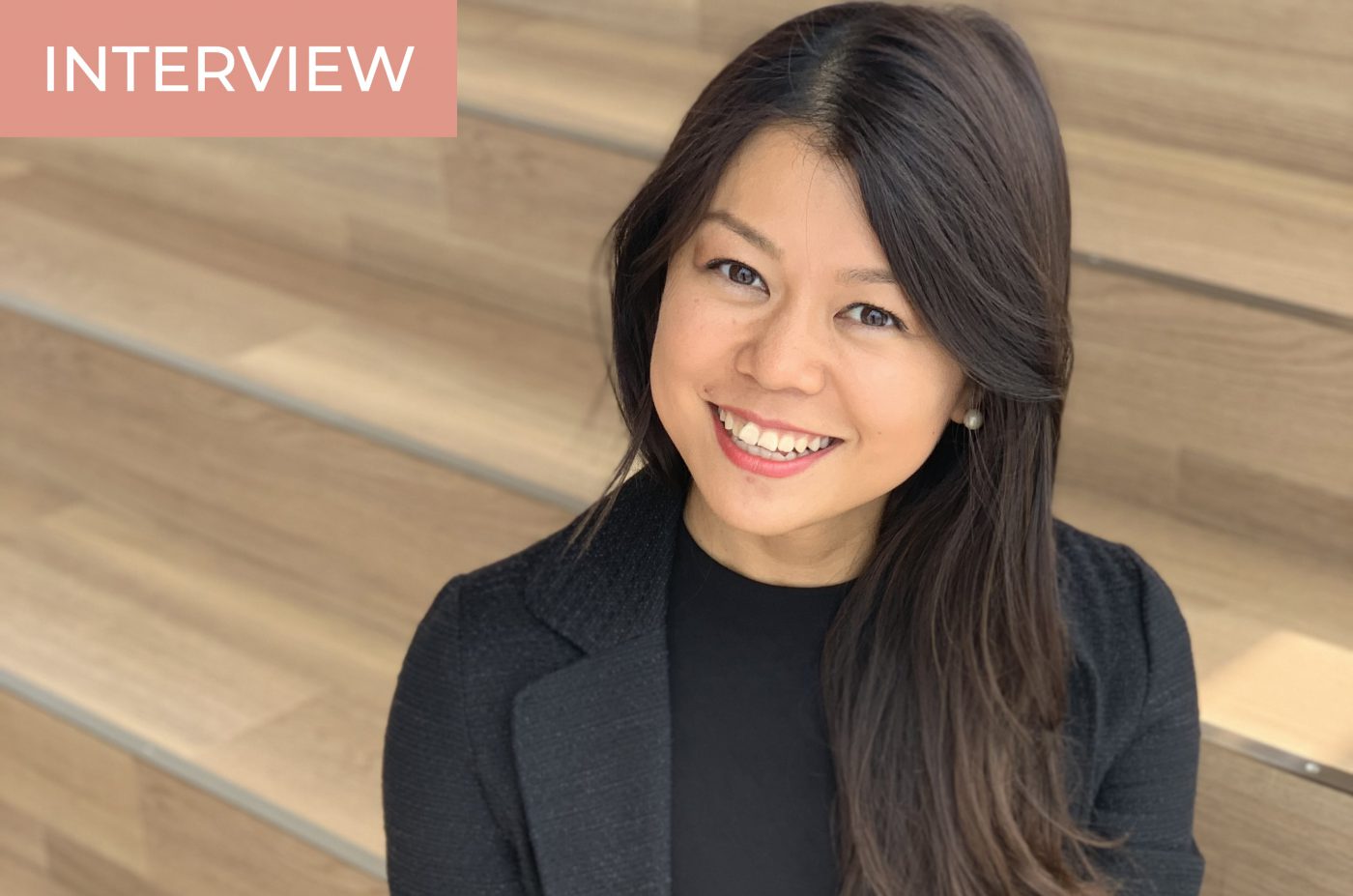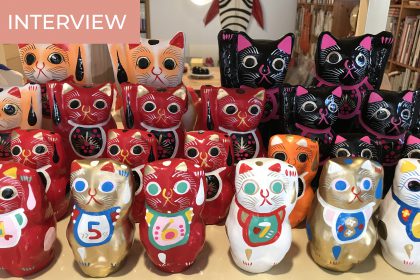Aki Sugiyama and her business partner Lillian Rowlatt have founded Kokoro Care Packages, a unique subscription service that allows customers to be delivered different kinds of Japanese ingredients and food monthly or seasonally.
When I first heard of this company, I was intrigued by our common choice for the word Kokoro in our respective brand names and was eager to learn more. I quickly discovered we do share a similar spirit. Kokoro Media wants to convey the soul and spirit of the people of Japan to the world through articles and interviews. Kokoro Care Packages, on the other hand, wants to convey the spirit of its food artisans and food culture by granting access to carefully selected products.
After a first contact with Aki, a very enthusiastic and philosophical person, I could not resist but ask her for an interview. Read on to discover why Kokoro Care Packages is a little more than just food and how Aki thinks food habits influence our way of thinking.
From Fitness Competitor to Founding Member of Kokoro Care Packages
Aki, I know you used to represent Japan at fitness competitions before starting this company. Could you please tell us about your career and the birth of Kokoro Care Packages?
After I graduated from university, I worked in a bank for about nine years. I was what the Japanese call a typical “office lady.” During the last three years, I discovered the world of fitness and bodybuilding. I think bodybuilding is something many people want to try but forming new habits is difficult. Being passionate about it sure helps. Before I realized it, I was representing Japan in competitions on the global stage! I did not think I would fall in love with this sport.
During the period I was training a lot, one of my colleagues told me, “There is someone I want to introduce you to. I feel like you are on the same page.” Then they introduced me to Lillian, their childhood friend, and we first met online. Lillian too had been passionate about fitness at some point in her life, and our personalities were very much alike.
Later, Lillian was able to come to Japan, and we went to eat together. We immediately became very close. We felt like twins that were separated at birth! Six months later, Lillian moved to Los Angeles and it was my turn to pay her a visit. That is when we started talking about our respective careers, about fitness and training, and thus, food. In fitness, careful eating represents 80% of what transforms your body, the training is only 20%. So, Lillian and I had learned a lot about food, which was another common point of us.
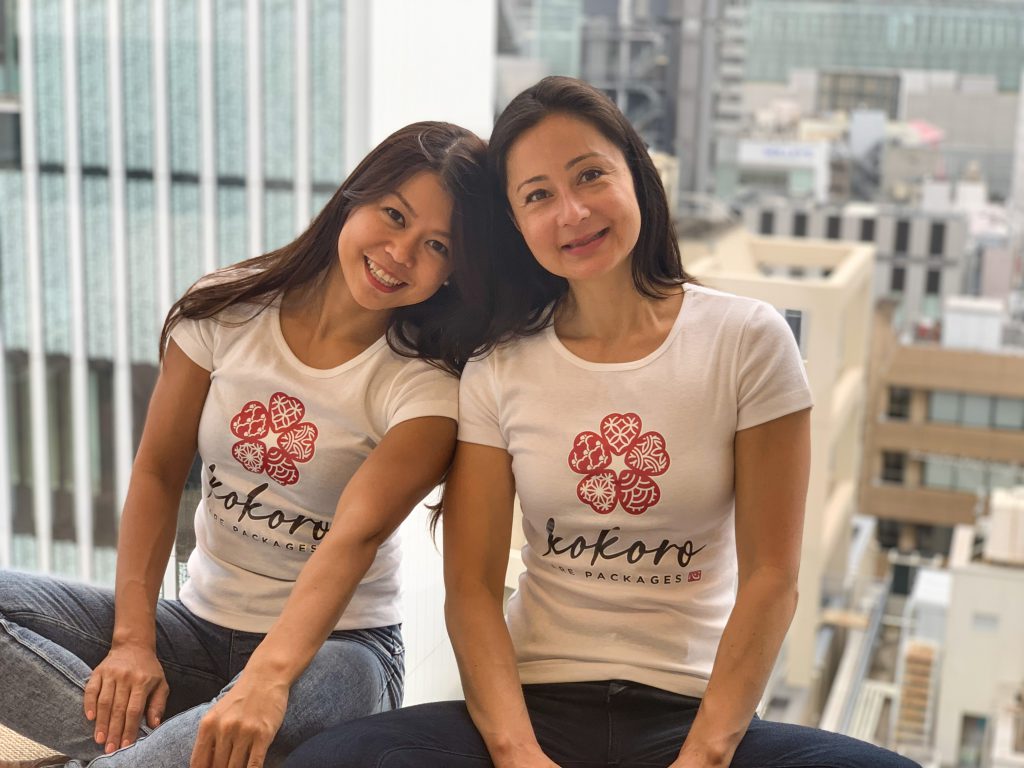
When I visited Los Angeles, I noticed Japanese food was getting very popular, but most of the things introduced contained a lot of chemicals and additives. Also, many products were said to be Japanese, but not made in Japan. Products of diverse levels of quality were displayed at the same place without any explanation. Lillian and I thought it would be nice if more good Japanese food were introduced. In the end, we decided we would do it ourselves!
I came back to Japan, but Lillian and I started working together remotely. The following six months, we planned our delivery system, our online platform, and more. As a result, we launched Kokoro Care Packages in December 2018. At first, we used crowdfunding to finance our business, and started growing our customer base from there.
Was it difficult to work with Lillian remotely?
First, you need to know that we have met in real life only three times. Even when we built the company, we did most things remotely. Usually, this would be extremely difficult. But Lillian and I get along so well and trust each other so much, it never has been a problem. We tend to agree on most things. I would not have been able to build a company remotely like this with anyone else.
When you change your attitude regarding food, your way of thinking changes as well.
Regarding what you said earlier about food and transforming your body, what have you become conscious of after starting to practice fitness seriously?
I started being careful about my calorie intake and macro nutrition balance, proteins, fats, and carbohydrates. I also took micronutrients, water intake and eating frequency into account. These are things you can control. And what I realized by doing so, is that when you change your attitude regarding food, your way of thinking changes as well.

Until then, I used to eat food without thinking. I was living a busy office life and I had kind of lost connection with my inner self. For example, I did not know what I really wanted to do in life. I was just shaped by my environment.
It was only after starting fitness that I started realizing what kind of life I wanted to live, and what kind of career I wanted for myself. It was one of the building steps on my way to founding Kokoro Care Packages.
So, you met Lillian just when you started realizing what you wanted to do in life. What great timing!
Yes, we often tell each other that this is how it was supposed to be! [laughs]
The Philosophy behind Kokoro Care Packages
We wanted to show more of the story behind each product and the craftsmanship side of the Japanese food culture.
Why did you choose to build a subscription service instead of an online shop where you buy Japanese food and ingredients?
There are a few reasons. The first is that the subscription market has only kept growing since 2010. Some subscription services are providing Japanese products and are very popular, but include mostly sweets and cookies. After talking with Lillian, we agreed that even though sweets are great, we wanted to show more of the story behind each product and the craftsmanship side of the Japanese food culture in general. We knew we would be the first ones to be positioned like this on the market. Online shopping would have been harder because there already were several big competitors out there. Also, a subscription service does not need as much stock as online shopping and allowed us to start small.
A subscription service is more sustainable in the long term, especially when we think of the local producers who live in rural Japan.
There is another merit to choosing a subscription service, which is to make our customers discover new tastes. Customers who shop online tend to buy products they already know, and it is harder for them to put products they have never eaten in their shopping basket. Through our subscription service, each month, our customers have access to food they are already familiar with, as well as new products to discover. They can taste new things and we provide recipes so they know how to cook them. We often receive comments saying, “I did not expect it to be so good,” or, “I did not know it was that easy to use.” Some customers even make requests to buy larger quantities of products they discovered in our packages.

Another reason is that since it is a subscription service, it is more sustainable in the long term, especially when we think of the local producers who live in rural Japan, whom we want to support. If they can say to potential customers that their products are selling outside of Japan and have received good feedback, Japanese people may be inclined to try them. Also, each producer makes different kinds of products, so we make sure to introduce their lineup little by little each month. It helps us to build a long-term relationship with the producers.
Finally, it is easier to build a community this way. We can get feedback more easily, which is important to us since we are a little too invested when choosing the products [laughs]. Our customers choose us because they like the fact that our ingredients do not include any chemicals, and mostly because they have a deep love for Japan. We hope to fuel their long-term interest in the country by building a lasting connection with them.
I hope we can enrich the hearts of our customers through food.
We have a huge common point, which is to have chosen “Kokoro” in our respective brand names. Why did you choose this word for your care packages?
Lillian said she wanted a name that sounded Japanese, and the kanji for “kokoro” is quite easy to recognize.
One of our missions is to convey the craftsmen’s feelings and what they are attached to when making their products. It is something you cannot access when you shop at the supermarket, for example. We wanted to express the fact that the producers put their hearts in the food you can find in our packages.
Also, I have come to think that food is not just about eating. It can create feelings such as nostalgia for a place and make you happy, or on the opposite, make you sad because there are some foods you cannot eat anymore. In Japanese, we have the expression “yutaka na kokoro,” which means “a rich heart.” I think using the five senses is a way to succeed in having this rich heart.
When I was an office worker, my five senses got blunt because I was barely moving and working on my computer all day. Also, life in Tokyo is following a very peculiar logic, considering that everything is fine as long as you are doing okay economically. I was not feeling like a human anymore and I did not know where to find my happiness. I guess that because of the pandemic, many people have tried to recover the access to their five senses and have realized how important they are.
Food is precious because it allows us to use our five senses, and I hope we can enrich the hearts of our customers through food.
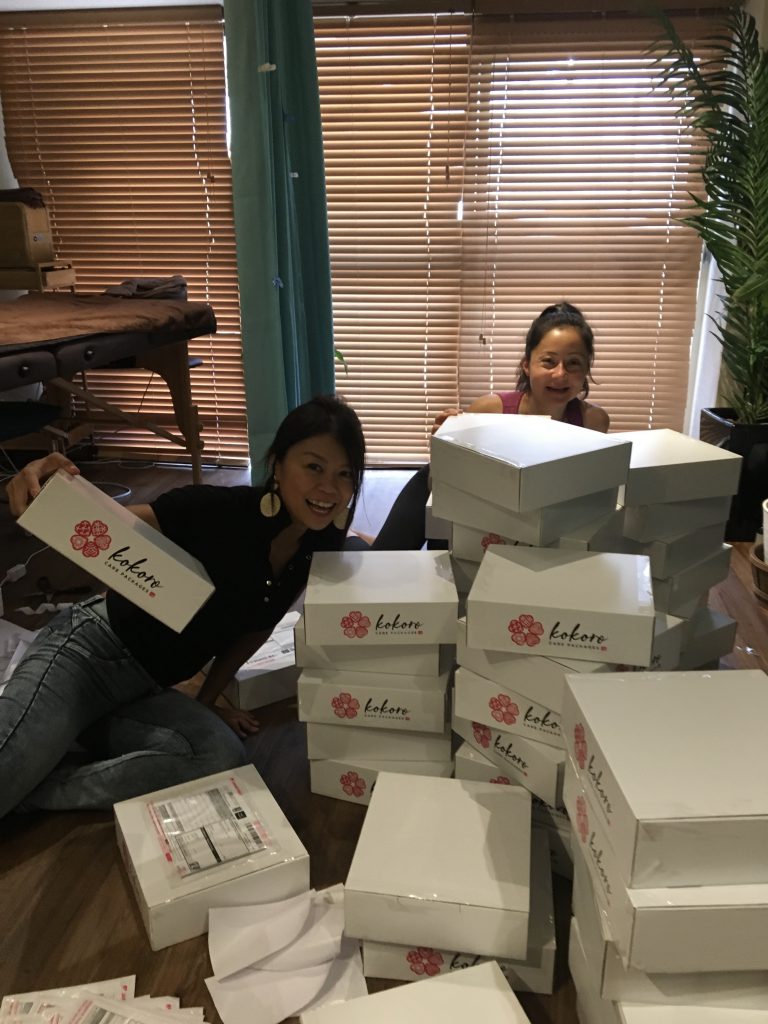
Bringing Japan to Your Table
Are there any other messages you would like to convey through your boxes?
Yes. A lot of people seem to think that Japanese food is difficult to cook. Some think that some steps must be followed thoroughly, or that certain ingredients should be used and not another. We would like to break these preconceptions, because we know it is a fun experience that can give birth to a renewed curiosity.
What are the main points you are careful of when choosing products for your packages?
Each box has a theme, so we have to make sure the products fit the theme. We also include foods of various categories in each box, for example, noodles, seasonings, side dishes, tea, sweets. We also make sure to include products that are as natural as possible, without chemicals.
We also select products that will be easy to use, but we also include a few that are a little unusual.
Can you give me an example of a rare product?
Last year, I found a condiment called natto koji (koji-fermented natto paste). It is natto that has been fermented again in koji, so it does not have the typical strong taste of natto.It is in a tube, which makes it easy to put it on bread or rice, or even on top of cheese on crackers. It got much more success than I expected. We received comments like, “I dislike natto, but this I can eat!”
Are you sometimes surprised by your customer’s comments or how they cook the ingredients you provide?
Yes! Do you know drip coffee bags? They seems to be not widely recognized overseas, and quite a few of our customers thought it worked like a tea bag. They found the coffee had almost no taste and we had to explain how such bags work. I had not realized it was not a common item outside of Japan.
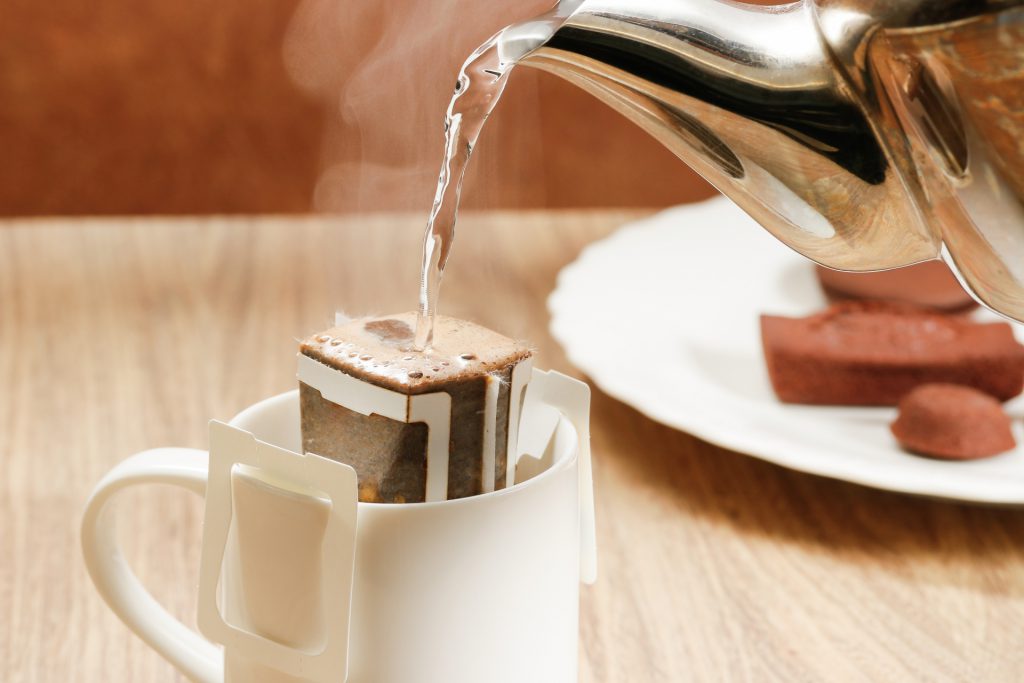
When looking at the posts by our community on Instagram, I am also admirative of how colorful our customers dish up the food on the plate. The colors are not mixed, but each color is taking its own space on the plate. Also, people tend to use mainly white plates. Visually, it is very different from what you can see in Japan.
Overseas customers also seem to look for stronger tastes, adding more salt than expected when a Japanese person would just use dashi [broth]. I have realized that saltiness is very important to them.
The attitude of our customers regarding additives is also interesting. They may be choosing our products for that reason, but many of them want to avoid chemical seasonings or high-fructose corn syrup. They inspect the products’ labels thoroughly before buying.
By the way, even if Japanese food has the reputation of being good for the health in general, products you can buy in the supermarkets contain a lot of chemicals and additives, and the labels do not always state it very clearly. In our packages, we include leaflets explaining where the food comes from, what ingredients are used, and who produced it. We also include recipes.
Do your customers also communicate with each other on Instagram?
Yes, sometimes they do, or they send each other messages. We are now thinking of creating a private Facebook group for our customers, so that they can exchange their impressions and recipes. We would love to also invite producers in the group so people can get to know them and ask them questions.
I would love it if people took the habit to include one or two sorts of dashi in their everyday cooking.
Is there a specific kind of food you would like foreign customers to know better?
Personally, I would like people to know more about dashi. I think that people are becoming familiar with dashi made from katsuobushi (bonito), konbu (kelp), or shiitake mushrooms. However, there are other kinds such as sardines, small dried sardines, flying fish, shrimp. There is also other vegetable dashi such as dried daikon.
There are many ingredients that contain the umami taste. All foods contain umami, but the ones with a lot of umami are known as major dashi ingredients. I would like people to know that thanks to umami, it is not always necessary to add too much salt to enjoy the savor of the ingredients. When the balance between salt and dashi is correct, then the dish becomes delicious. If the umami is strong then you just need a little salt, and if the dish lacks umami, you need to add more salt. It is actually pretty simple.
I would love it if people took the habit to have one or two sorts of dashi in their kitchen pantry. Actually, many young Japanese people do not do this either, because many of them have stopped making their own dashi and rely on umami seasoning, so-called MSG.
Through the philosophy of Japanese food, you realize that everything needed was there from the beginning.
Another thing I would like people to know is the logic behind Japanese cuisine. In French or Italian cuisines, for example, the key is to add different flavors to each ingredient to create a delicious taste. On the opposite, Japanese cuisine is about subtracting: removing anything useless from the original ingredients to leave only their original deliciousness. For example, when boiling or simmering something, we carefully remove the skim.
Lately, I have come to think we could inspire ourselves from this philosophy to improve our lifestyle. Nowadays, we easily feel that we lack time, money, skills, or information and we want to build them up. We feel we are not enough and are always looking for more. I tend to do this, too. But through the philosophy of Japanese food, you realize that everything needed was there from the beginning. And you can start to apply this philosophy to other parts of your life.
It is an interesting coincidence, but I have recently interviewed a Shugendo monk whose philosophy is very similar to this! He told me that everything was about subtracting instead of adding.
How interesting! I think more and more people are noticing this because of the pandemic.
What are your objectives for the future?
Of course, we want to reach more people. Personally, I would increase the “experience” aspect of each box, give something more than just food. I would like to use it as a way to educate about Japanese food and even food in general, and convey the food philosophy I was talking of earlier.
For example, I would like to add some reading material about food culture, and some recipes recommended by the food producers themselves. I love reading on paper, so rather than digitally, I would like to put this under the form of a booklet.
Also, recently, we created a box in collaboration with Kanagawa Prefecture, introducing its local gourmet food. We would like to pair food with tourism, and collaborate with other prefectures in the future. We hope to make people want to visit rural areas of Japan when we can travel again.
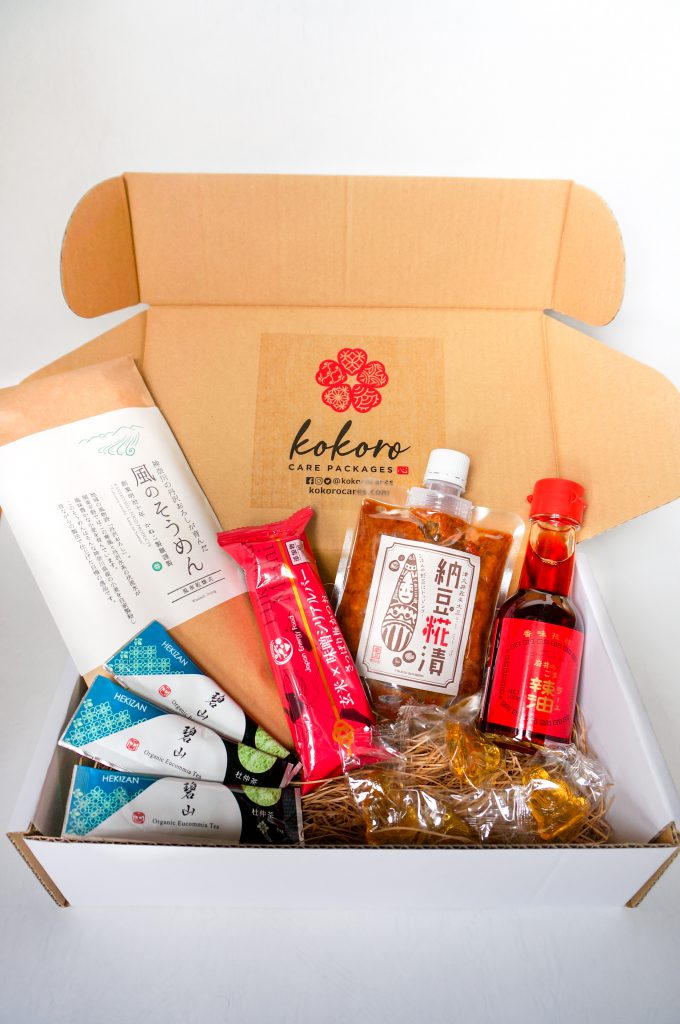
Exploring One of the Kokoro Care Packages
After talking with Aki, I got curious to see under which forms the philosophy she had explained to me was presented to customers. I asked if I could be provided with one of the packages, and was invited to choose my favorite among the four “Collections Care Packages,” which are one-time purchases to start discovering Japanese food. I chose the “Wa” package, including several cooking essentials of Japanese cuisine.
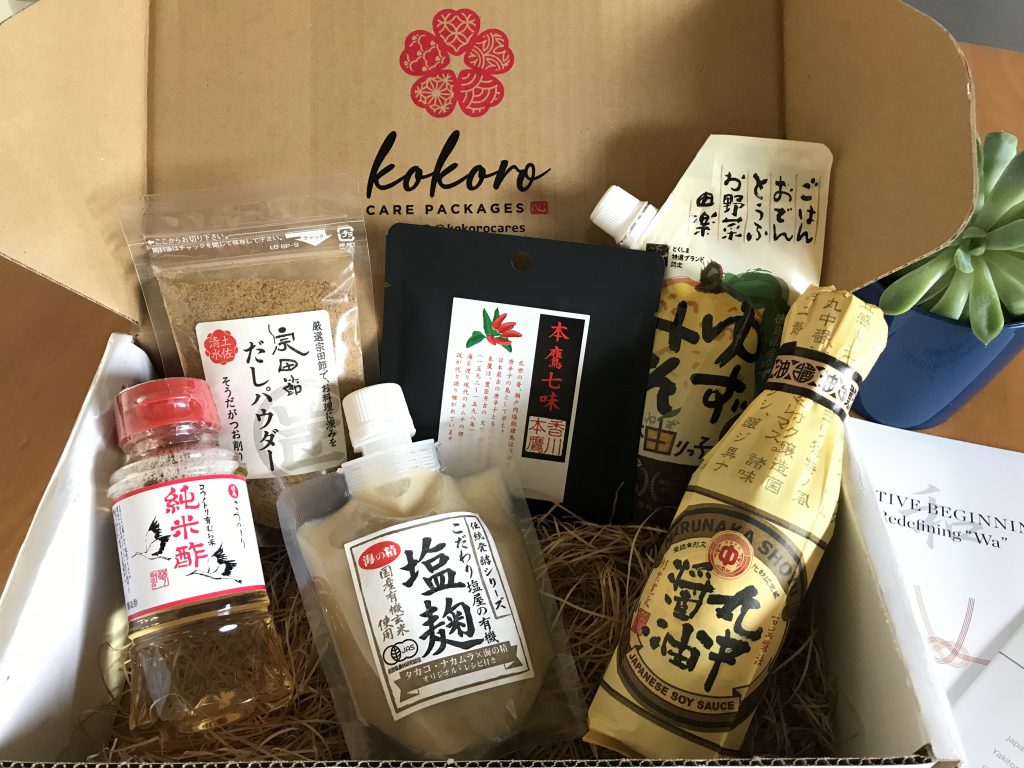
When I opened the box, my first happy surprise was to see that there was no plastic used to protect the different products inside the box; the second, to read my personalized thank you card. The products in the box were: soy sauce, rice vinegar, shio koji, yuzu miso, bonito dashi, and shichimi togarashi (Japanese chili powder). The box also contained one explanatory leaflet and one leaflet with recipes.
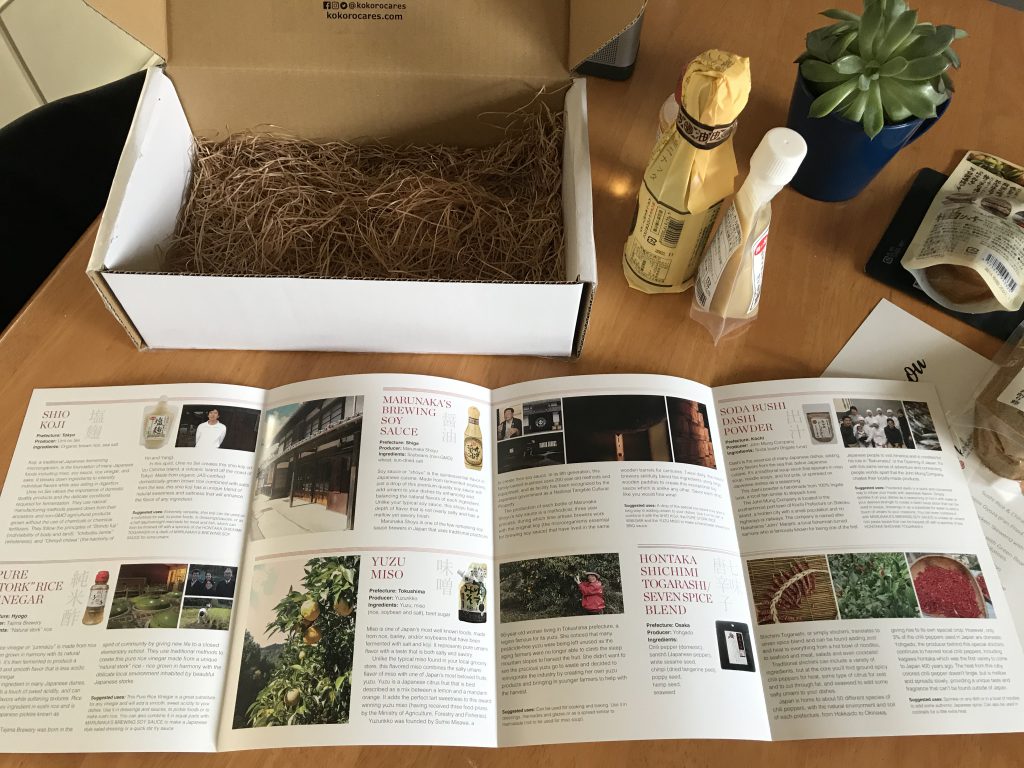
I could not wait to try the ingredients, so I made myself an easy lunch with most of them. First, I decided to cook gyoza (ready-made), because the common way to eat them in Japan is to dip them in a sauce made of soy sauce and vinegar. The soy sauce in particular was very impressive: just by smelling it, I could tell its flavors were richer than the organic soy sauce I usually buy at my local supermarket. The taste had a depth I honestly did not expect.
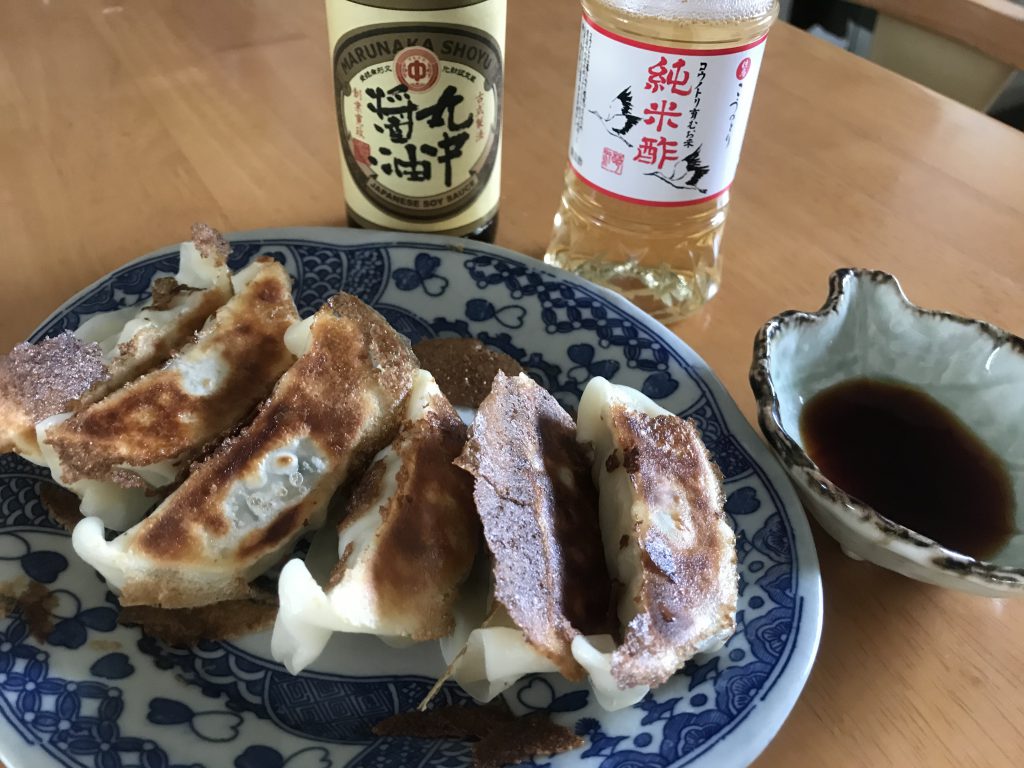
Then, I made my own original salad dressing by mixing shio koji, yuzu miso, and olive oil. One reason is I had never used shio koji before, and the presentation leaflet said it could be used instead of salt, which I did. When tasted as is, I was immediately hooked on its umami and mild flavor. I was also very curious about yuzu miso, because the leaflet suggested (among other uses) to use it on bread like marmalade. I had yuzu miso before, and could imagine myself doing that. However, this yuzu miso is so sweet and the miso taste is so gentle, I understood what they meant. I was lucky with my try at this dressing, as the three ingredients complemented each other perfectly.

At night, I made one of my favorite dishes, niku jaga (beef and potatoes simmered in soy sauce and other ingredients), and a miso soup using the bonito dashi. Like the soy sauce, the dashi smell was very rich in flavors, and I had to make some adjustments to make my miso soup because I was too used to my usual dashi that has much less umami.
Since I have been living in Japan for 10 years, having traveled in rural areas and tasted many local products, I anticipated good quality ingredients, but honestly did not expect to be that surprised. The contents of the package did reflect the care Aki gives to choosing the best products possible, and effectively broke some of my preconceptions. If I received such a package each month, I would definitely get excited.

